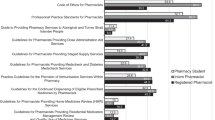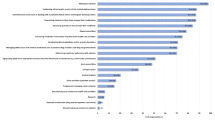Abstract
Objective To determine UK non-medical prescribers’ (NMPs) (supplementary or independent) current participation and self-reported competence in pharmacovigilance, and their perceptions of training and future needs. Setting Non-medical prescribers in health care in the United Kingdom. Awareness of and participation in the Yellow Card Scheme (YCS); attitudes towards ADR reporting; strategies to encourage reporting; pharmacovigilance training; and demographics. The sample comprised nurse (n = 912) and pharmacist (n = 2,439) NMPs in the UK. Main outcome measures Self-reported competence in pharmacovigilance, knowledge of and participation in the YCS, attitudes towards ADR reporting; strategies to encourage ADR reporting; pharmacovigilance training during NMP training. Results Six hundred and thirteen responses were received giving an overall response rate of 20.4 %. Response rates for nurse and pharmacist prescribers were 32.2 % (n = 293) and 13.1 % (n = 320) respectively. Three hundred and fifty-nine respondents (58.6 %) had submitted a Yellow Card. Although the majority of respondents (70.4 %) felt competent in pharmacovigilance, a third (34.2 %) said they needed further training. Respondents reported a positive attitude towards ADR reporting, yet only a minority (22.9 %) correctly answered factual questions about the YCS. Approximately a third of respondents (35.6 %) “couldn’t remember” if pharmacovigilance was covered in their prescribing training. Publicity and education were commonly suggested measures to enhance contribution to the YCS. Conclusion While NMPs report participation and competence in ADR reporting, there are several key issues to consider including the need for further training and support to optimise their role in pharmacovigilance.
Similar content being viewed by others
References
Meyboom RGB. Data assessment in pharmacovigilance. [cited Sept 2011] http://www.ikev.org/haber/farmakovijilans/Meyboom%20Data%20Assessment.pdf.
Medicines and Healthcare products Regulatory Agency. Yellow card, helping to make medicines safer. [cited Sept 2011] http://yellowcard.mhra.gov.uk/.
Hazell L, Shakir SAW. Under-reporting of adverse drug reactions: a systematic review. Drug Saf. 2006;29(5):296–385.
Lindquist M. Data quality management in pharmacovigilance. Drug Saf. 2004;27(12):857–70.
Department of Health. Supplementary prescribing by nurses, pharmacists, chiropodists/podiatrists, physiotherapists and radiographers within the NHS in England: a guide for implementation 2005. Department of Health, London.
Department of Health. Improving patients’ access to medicines: a guide to implementing nurse and pharmacist independent prescribing within the NHS in England 2006. Department of Health, London.
Stewart D, MacLure K, George J. Educating non medical prescribers. Brit J Clin Pharm. 2012;74(4):662–7.
Sweis D, Wong IC. A survey on factors that could affect adverse drug reaction reporting according to hospital pharmacists in Great Britain. Drug Saf. 2000;23(2):165–72.
Green CF, Mottram DR, Rowe PH, Pirmohamed M. Attitudes and knowledge of hospital pharmacists to adverse drug reaction reporting. Brit J Clin Pharm. 2001;51:81–6.
Morrison-Griffiths S, Walley T, Park BK, Breckenridge AM, Pirmohamed M. Reporting of adverse drug reactions by nurses. Lancet. 2003;361:1347.
Sri Ranganathan S, Houghton JE, Davies DP, Routledge PA. The involvement of nurses in reporting suspected adverse drug reactions: experience with the meningococcal vaccination scheme. Brit J Clin Pharm. 2003;56:658–63.
Bracchi RCG, Houghton J, Woods FJ, Thomas S, Smail SA, Routledge PA. A distance-learning programme in pharmacovigilance linked to educational credits is associated with improved reporting of suspected adverse drug reactions via the UK yellow card scheme. Br J Clin Pharm. 2005;60(2):221–3.
McColl E, Jacoby A, Thomas LN, Soutter J, Bamford C, Steen N, et al. Design and use of questionnaires: a review of best practice applicable to surveys of health service staff and patients. Health Technol Assess. 2001;5(31):1–256.
Edwards PJ, Roberts I, Clarke M, Diguiseppi C, Wentz R, Kwan I, et al. Methods to increase response to postal and electronic questionnaires. Cochrane Database Syst. Rev. 2009;Jul 8(3).
George J, McCaig D, Bond C, Cunningham ITS, Diack HL, Watson AM, et al. Supplementary prescribing: early experiences of pharmacists in Great Britain. Ann Pharmacother. 2006;40:1843–50.
George J, McCaig D, Bond C, Cunningham S, Diack L, Stewart D. Benefits and challenges of prescribing training and implementation: perceptions and early experiences of RPSGB prescribers. Int J Pharm Pract. 2007;15:23–30.
Courtenay M, Carey N, Burke J. Independent extended and supplementary nurse prescribing practice in the UK: a national questionnaire survey. Int J Nurs Stud. 2006;44(7):1093–101.
Bowling A. Methods in health research. Buckingham: Open University Press; 2002.
Fisher RJ. Social desirability bias and the validity of indirect questioning. J Consum Res. 1993;20(2):303–15.
Lopez-Gonzalez E, Herdeiro MT, Figueiras A. Determinants of under-reporting of adverse drug reactions: a systematic review. Drug Saf. 2009;32:19–31.
Thomas G, Pring R. Evidence-based practice in education. Berkshire: Open University Press; 2004.
Gavaza P, Brown CM, Lawson KA, Rascati KL, Wilson JP, Steinhardt M. Influence of attitudes on pharmacists’ intention to report serious adverse drug events to the Food and Drug Administration. Br J Clin Pharm. 2011;71(1):143–52.
Avery A, Anderson C, Bond C, Fortnum H, Gifford A, Hannaford PC, et al. Evaluation of patient reporting of adverse drug reactions to the UK ‘Yellow Card Scheme’: literature review, descriptive and qualitative analyses, and questionnaire surveys. Health Technol Assess 2011;15(20):1–234.
Acknowledgments
We acknowledge the contribution of the following organisations to recruiting nurse and pharmacist prescribers: Association for Nurse Prescribing; NHS Education for Scotland; Centre for Postgraduate Pharmaceutical Education; Northern Ireland Centre for Pharmacy Learning and Development; Welsh Pharmacy Board; National Prescribing Centre; and Royal Pharmaceutical Society. We are also grateful to those nurse and pharmacist prescribers who participated in the research.
Funding
The UK Medicines and Healthcare products Regulatory Agency (MHRA) funded this research.
Conflicts of interest
None.
Author information
Authors and Affiliations
Corresponding author
Rights and permissions
About this article
Cite this article
Stewart, D., MacLure, K., Paudyal, V. et al. Non-medical prescribers and pharmacovigilance: participation, competence and future needs. Int J Clin Pharm 35, 268–274 (2013). https://doi.org/10.1007/s11096-012-9739-7
Received:
Accepted:
Published:
Issue Date:
DOI: https://doi.org/10.1007/s11096-012-9739-7




